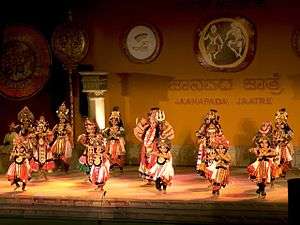Jaanapada
Jaanapada is a word made by two words Jana - People or tribe Pada - a kind of short verse joined together as a sandhi- a grammatical term. The folk culture and colloquial tongue of Kannadiga and probably Telugu people were known by this name from time the languages came into existence.
The Tongue
- Proverbial Gaade which has a famous saying in Kannada as Veda sulladaru Gaade sullagadu -meaning even if Vedas are proved wrong practically, Gaade can never go wrong.
- Small songs which are sung on every occasion like marriage, festival, travel and most importantly on every work done mostly from harvest to cooking.
- Religious pada like those of Dasa Saahitya and Vachana Saahitya and probably even the literature of Guru shishya tradition which is known to only be passed through ears and not on papers can be put into this broad term. Shishunala Shareefa,Purandara Dasa, Kanaka Dasa, Sarvajna stand at top as wandering saints.
In practice the language of people since the time it developed in India can be attributed as Jaanapada as dialects varied from place to place greatly. Hence before the languages developed a script for themselves Jaanapada was the term used to denote the language spoken. Even now all languages or rather dialects of South India don't have script of their own and not very conservative of grammar and which ever language does have seems to carefully amalgamate from the folk languages and their words reaching a finesse.
The Art

The art of composing verses was natural when people were deeply involved in their works commonly related to agriculture, pottery, harvest, flouring grains.
There were also compositions on rituals which were laid on common man when caste system was on peak to oppose the atrocities and understand the traditions.
Normally the Jangama or wandering monks or the Dasa or wandering devotee who used to hold a tamboori - a famous instrument to add muse the verses, used to travel places spreading the knowledge they had acquired and used to receive alms from people known as Bhavathi Bhiksha Dehi which does not find a right word in contemporary English.
Apart from these the folk dance arts added colour to expressions rather than words and were popular at mass gatherings.